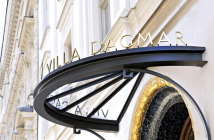Kajitsu, the name of the discreet subterranean Japanese restaurant in Manhattan’s Lower East Side, means ‘a fine day’, which is something you can be assured of having should your diurnal cycle happen to conclude within its enlightening confines.
Upon entering, don’t let chef Nishihara’s youthful glow fool you. He spent over 12 years learning the intricate art of kaiseki cuisine; 10 in Kyoto and two in Nagano, where he specialised in producing the multicourse affairs of hand-made buckwheat soba noodles. He brought all of this experience with him to New York two years ago and, for some unknown reason, no one really seems to have noticed. That is, if you ignore Messieurs Michelin, who promoted the restaurant to two stars in last year’s guide.
Kajitsu serves shojin ryori cuisine, a purely vegetarian form of gastronomy that was popularised in the 13th century by Chinese Zen monks in Japan, and is still served in Zen temples today. And, if these monks’ food is anything like what I recently sampled, no wonder they always seem so happy.
The meal was a fascinating vacillation between the paring down and joining together of exquisite ingredients.
Our opening course set the tone for what was to come. The most delicately fried cubes of Trumpet Royale mushrooms had been wedded to fresh persimmons and pine nut cream. The green and golden pyramid was presented inside individual clay dishes which resembled blossoming flowers. The ingredients bled umami on the palate (luckily not the plate), with the sweet and tangy persimmon ably dabbing up the spillage.
So immersed was I in this dish that I was taken aback when a fellow diner at the other end of the chef’s counter snuck up behind me and tapped me on the shoulder. “I also photograph my food,” he offered. I felt like telling him, “That’s probably not something you want to gloat about to a stranger – even if he also has the peculiar habit of recording every potentially memorable bite he consumes – especially now that you’ve got the chef’s attention, numbskull.” Rudely ignoring my internal rant, he continued, “I was so eager to taste this course that I forgot to take a picture of it before I dug in. So I was wondering if, um, I could take a picture of yours.” My dining partner and I couldn’t help but smile, and let him complete his simultaneously innocuous and brave task before shuffling back to his stool to show off the stolen image to his other half.
The next course, a seemingly simple carnelian yellow and “scarlet-tinged” minestrone soup consisting of kabocha squash, bell peppers (which I normally hate – and yes, hate is a strong word), yellow yuzu and the mild but flavorful shichimi togarashi (seven spice), maintained my interest throughout, with citrus and chili notes peppering my tongue while I enjoyed the savory yet ever-so-sweet sweet broth.
And so it went: complex followed by ‘simple’.
Our third course was fittingly composed of three separate dishes, each more elaborate than the last. Let’s just say it involved wheat gluten which had been fashioned to resemble yellow maple leaves with orange edging; three rice cigars wrapped with tofu skin, crowned with beads of ‘land caviar’ (cypress seeds) and complemented by the best ginger I’ve ever tasted, and an immaculate pile of braised enoki mushrooms with nori, daikon and a radish wedge that provided a peacock-worthy splash of color.
This was followed by soba noodles with dipping sauce. While this is a dish you can order in any number of Japanese restaurants, the noodles won’t likely be made in-house and certainly won’t taste or feel like this – the texture was springy and superb – and the unusual addition of fresh wasabi was a welcome one.
The main course was certainly the triumph of the evening, both in visual affect and deliciousness. An assembly of vegetables – some raw, some steamed, some fried; some warm, some cold, some neither – resembled autumn leaves that had been raked together into a pile similar to those you see at the end of proud homeowners’ driveways. The foliage was sprinkled with edible ‘pine needles’, which were actually brittle green tea noodles. This was both substantial and without a doubt one of the tastiest dishes I’ve eaten in some time, endlessly dazzling in its variety of textures and tastes, with no dud notes to speak of. Lying next to the leaves was a wooden wrapper, beneath which lay a row of cedar-smoked, green wheat gluten and portabella mushrooms that was surrounded by soft walnuts and a sticky combination of red miso paste and salsify. This was also surprisingly, and quietly, good.
A straight-forward bowl of steamed rice dotted with chestnuts was pleasant enough, but it was the trio of pickles residing next to it that made a good case for being a dish on its own.
Desserts continued down the same path, each containing only a few ingredients that were perfectly confident spending time with themselves. A diminutive mochi pancake with dates and sweet azuki bean paste was branded with the logo of the restaurant – a circle/square/triangle image descended from an ancient Buddhist story in which the master tells the student that once he realises the meaning of these three shapes he will truly be wise. I am, alas, still pondering.
Soft and delicate, the pancake led us to our final unassuming course of rice cracker candy and green tea. The chef whisked the matcha right in front of us and, while there was not much liquid in the bowl, it packed a punch. The surprise of the meal was learning just how good a sweet rice cracker could be – it was out of this world (well, definitely from out of this country), and perfectly offset the intensity of the frothy green tea.
The meal hadn’t actually lasted that long, and my companion and I lingered for another hour or so talking about relationships and food. At one point, the chef came up to us and smiled as he presented us with an extra nibble: a mini sweet potato ice cream ‘hamburger’ with a single walnut topping. This was subtly divine, and I was glad that the crunch of the light rice cracker ‘bun’ – coupled with the flavour of cool, sweet yams – was my final bite of the evening.
As I left, I felt completely content and not the least bit bloated. Despite a successful pairing of five sakes, I also felt remarkably lucid. The meal was something of a revelation as, without basic kitchen foundations such as dairy butter (the food is suitable for vegans), chef Nishihara was able to create a delightful meal that never seemed wanting in any regard.
In fact, his food resembles the enigma of traditional Japanese culture I experienced when I visited the country some years ago: it has been developed over a long period of time; it is undeniably beautiful and painstakingly considered, and it has a sea of emotions bundled up at its core. You may or may not experience the emotions, depending on your state of mind at the time, but they are worth discovering.
Given that the seasonal menu changes with the months, there is much still to be unearthed from this serene and (still) hidden goldmine.
Kajitsu, 414 East 9th Street, New York, NY 10009. Tel. +1 212 228 4873. Website.





1 Comment
Great writing and pictures. Many happy memories or our visit last year.